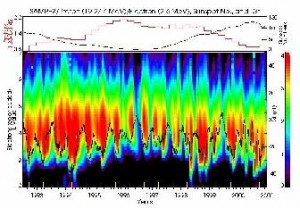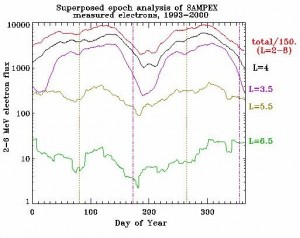Long Term Measurements by SAMPEX Reveal Fascinating Features of Radiation Belts
The Earth’s magnetosphere efficiently accelerates and subsequently traps energetic particles. The outer radiation belt consists of electrons with energies of hundreds of keV to several MeV. SAMPEX has provided a picture of the radiation belts as a function of L (where L is the radial distance in Re at the equator if Earth’s magnetic field is approximated as a dipole), near the foot of the field line. Figure 1 shows SAMPEX’s measurements of radiation belt electrons and protons from launch to the end of 2000 together with the sunspot number and the Dst index, a major indicator of magnetic storms with a more negative Dst indicating stronger magnetic storms. The inner proton belt is relatively stable and varies over the time scale of the solar cycle or longer and is anti-correlated with sunspot numbers. The slow variation of inner proton belt is in contrast to the outer electron belt, which varies on a range of time scales.
Several distinct features are notable in the long term electron measurements. The outer belt exhibits a strong seasonal and solar cycle variation. It was most intense, on average, during the descending phase of the sunspot cycle (1993-1995), weakest during sunspot minimum (1996-1997) and then became more intense again during the ascending phase of the solar cycle (1997-1999). Interestingly, the electrons are not most intense approaching or at sunspot maximum conditions. We would expect much enhanced outer belt electrons 2-3 years from now
Another remarkable feature of Figure 1 is the correlation of the inward extent of MeV electrons with the Dst index. For the more 8-year’s observations, the two weakest electron periods corresponded to the only periods, summer of 1996 and 1999, when the averaged Dst was above zero.
Both Dst and the electrons show a strong semiannual variation. The outer belt is most intense around the equinoxes [Baker et al., GRL, vol. 26, 3193, 1999] and also penetrates the deepest around the equinoxes. Equinox periods are marked by the vertical bars along the horizontal axis in Figure 1. This semiannual variation is more pronounced at lower L and there is also a larger phase shift of the electron flux peak from the equinoxes, which is further illustrated by Figure 2 , a superposed epoch plot of 8-year’s SAMPEX measurements.
This semiannual variation has been investigated using newly developed models that accurately predict these variations of Dst [Temerin and Li, GRL, submitted, 2001] and radiation belt electrons at geostationary [Li et al., GRL, vol. 28, 1887, 2001]. given the solar wind input. We concluded that the semiannual variation of the Dst index and MeV electrons deep in the inner magnetosphere can be attributed mostly to the equinoctial effect, that is the varying angle of the Earth’s dipole with respect to the Earth-Sun line or rather the solar wind velocity and thus presumably a varying efficiency of coupling with the solar wind. This latest work has been submitted to Geophysical Research Letter.
Figure Captions: Figure 1. (http://uleis.umd.edu/docs/lijune2001fig1.pdf) Selected SAMPEX measurements of protons (\#/cm^2-s-sr-MeV) and electrons (\#/cm^2-s-sr, in bins of 0.1 L) since launch (July 3, 1992) and sunspot number and Dst index for the same period. The protons and sunspot numbers are window-averaged over a 9-month period and the electron and Dst index are window-averaged over a 30-day period in order to show the overall feature. The yellow vertical bars on the horizontal axis are marks of equinoxes. Figure 2. (http://uleis.umd.edu/docs/lijune2001fig2.pdf) Eight-year (1993-2000) superposed epoch plot of 2-6 MeV electron fluxes measured by SAMPEX at different L-value. The total flux is summarized from L=2 to L=8. The equinoxes and solstices are marked by the vertical dotted lines and dash-dotted lines, respectively.
Contributed by Xinlin Li, University of Colorado
«Return to the Results page

